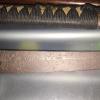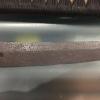I recently acquired this blade, can anyone help with mei translation? any other information anyone could give would also be appreciated. much thanks!
|
|||||||||||||
 |
Nihonto ClubJapanese Sword Information Exchange |
User login |
|
|
Disclaimer: Nihontō Club owners and independent contributors will not be held responsible for any loss, damage or inconvenience caused as a result of any inaccuracy or error within this website. Except where otherwise noted, this page is licensed under a Creative Commons License.
|





Masakiyo
Appears to be "BISHUu MIHARA JUu MASAKIYO SAKU".
Pete
more info
Thanks Pete!
Any ideas on where to get more info on this swordsmith? when it may have been made?
michael
maybe MAS348/349
Hi, Based only on a quick look in a couple of books, my "guess" is MAS348 or MAS349.
These are my guess for this reason only:
They both signed including the phrase "...MIHARA JUu MASAKIYO..." - Other Masakiyo smiths were not known to sign that way, but it doesn't mean that they didn't.
MAS348/349 are 16th century. They are not "important" smiths, so info will be very hard to find. They are listed in Hawley's book (that's where the "MAS348" and "MAS349" comes from), which means they are probably listed in the Nihonto Meikan (I don't have that book).
In general, all the "better" smiths before the 20th century are listed in Fujishiro's books, but I found only one Masakiyo with the same kanji for MASA and KIYO, and it's definitely not yours.
If you Google "MIHARA MASAKIYO", you'll see some examples of the "better" ones. Note the style of the MASA kanji - yours is a very simple Kaisho style (like in a dictionary), while the more famous ones are more curvy.
Pete
[ FYI, I have this pair of swords for sale:
http://yakiba.com/Daisho_Tango_no_Kami_Kanemichi.htm ]
great info!
thanks so much for the info, this is a great starting point for me.
may I ask what books you are using? I need to start collecting books as well!
best, michael
BTW, beautiful swords! I have a really nice Harley I might be willing to trade!
books
There is quite a lot of good info online these days, including Stan's "Swordsmith Index" and other things on this site.
The main books that I've used over the years:
"Japanese Swordsmiths Revised" by Hawley. In English. No detailed info, but it lists every smith you are likely to see, and what kanji were typically used in their signatures. It was compiled from several of the classic Japanese books, such as Nihonto Meikan. Years ago, I used info from the book to create the first computer database of smiths, called "ToShoW". My database became the starting-point for many/most of the online databases that are out there today.
Hawley gave each smith a "rating" number from 5 to 400, that was supposed to indicate the quality/importance/value of that smith. Years ago, most Western collectors believed that the Hawley number was very important. Some still do. My opinion is that it's not very useful, because any given smith can produce work that is very good or very bad. And, Hawley arbitrarily gave a very low number to ALL WWII-period smiths, even though some (like the Yasukuni Jinja smiths) are considered very good.
"Koto Hen" and "Shinto Hen" by Fujishiro. In Japanese. If I was to keep only one book, I would keep this 2-volume set. Harry Watson published an English translation without the pictures. This is NOT a general-info book; rather it is an encyclopedia of nearly every "good" smith before the 20th century.
"Connoisseur's Book of Japanese Swords" by Nagayama. A very good general info book (not so much info on specific smiths). For a novice collector, this book (or others like it) are what I would recommend as their first book.
John Yumoto's book "The Japanese Sword", is a major classic for English speakers, but it doesn't actually have a lot of info in it - it's fairly basic. But when it came out, it was the best. It's like a smaller, simpler version of Nagayama's book. John Yumoto was probably the most important American collector when he was alive.
Learning the basics of Japanese kanji characters is a good idea, also.
There are certainly other good/famous books...
Pete
[ I have this pair of swords for sale:
http://yakiba.com/Daisho_Tango_no_Kami_Kanemichi.htm ]